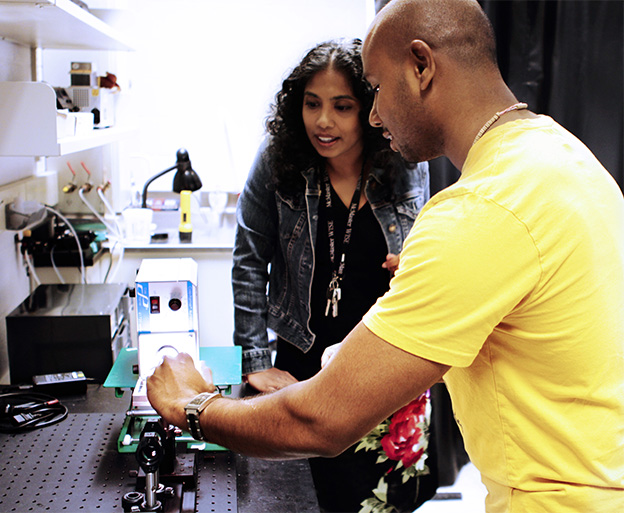Shining a light on … light

PhD student Dinesh Basker is studying how a single incandescent light-beam can spontaneously create 40,000 cylindrical waveguides. He is seen here with his thesis supervisor, associate professor Kalaichelvi Saravanamuttu of McMaster’s chemistry and chemical biology department.
Dinesh Basker applied to graduate schools around the world. He was accepted to three, but you might say he “saw the light” in choosing McMaster.
“I was interested in coupling chemistry with physics,” says Basker, who hails from the province of Tamil Nadu in India.
As he looked into options for graduate study, he learned about the work of associate professor Kalaichelvi Saravanamuttu in the Department of Chemistry and Chemical Biology. Her research group combines physics and optics with chemistry to examine systems that simultaneously undergo chemical and optical changes.
“There are very few people working in this field who combine chemistry with optics,” says Basker, who was accepted as a master’s student and has since successfully transferred to the PhD track.
Basker received an engineering degree from the Madras Institute of Technology at Anna University, studying rubber and plastics technology. “I decided I have to be in this field,” he says.
He explains that the Saravanamuttu group studies opto-chemical phenomena, including the creation of light tubes, or waveguides, using various kinds of polymer materials. Photochemical reactions are triggered, which spontaneously divide one light beam into tens of thousands of discrete filaments.
Essentially, the process can be described in lay terms as “making about 40,000 light-guides with one low-cost white light bulb.”
A waveguide is any kind of physical structure that guides waves, such as electromagnetic waves or sound waves. An optical waveguide serves to guide light for many purposes from photonic devices to fiber optic cables.
Basker’s doctoral research expands on the Saravanamuttu lab’s work by using cylindrical light-guides made of epoxide, a material that has good mechanical and thermal stability. Epoxide “is like a gold of a polymer,” says Basker. “It’s used everywhere, when you want to fabricate something tough.”
“We were working with a particular type of material for all our previous experiments,” says Saravanamuttu. “Then Dinesh showed us that we could actually see the same process with a much tougher material, through a different type of chemistry. That was really an ‘aha’ moment for us. We saw that we could really tune the materials to our needs. That has been one of Dinesh’s key contributions to the group.”
Basker is quick to point out that their research is in the early exploratory stages. “Honestly speaking, we are still trying to understand this phenomenon. There’s a lot of interesting science involved in it.”
However, there are definite possibilities for practical applications down the road. “Dinesh’s work opens an inexpensive, single-step and room-temperature route to robust light guiding architectures that would be extremely challenging and expensive to fabricate through conventional means,” says Saravanamuttu.
A provisional patent has been filed for her lab’s work, which is funded through an NSERC Strategic Project Grant, jointly held by Saravanamuttu and Michael A. Brook, an organic chemist at McMaster. Current studies are examining the potential of these waveguide architectures as light-harnessing and light-guiding coatings that could improve the efficiency of optical devices including solar cells.
Along with his doctoral research, Basker also works as a teaching assistant, helping undergraduates with their research, marking exams and leading tutorials. And while he has only just begun work on his thesis, there is no question what his future plans are. “I want to do research for the rest of my life.”

